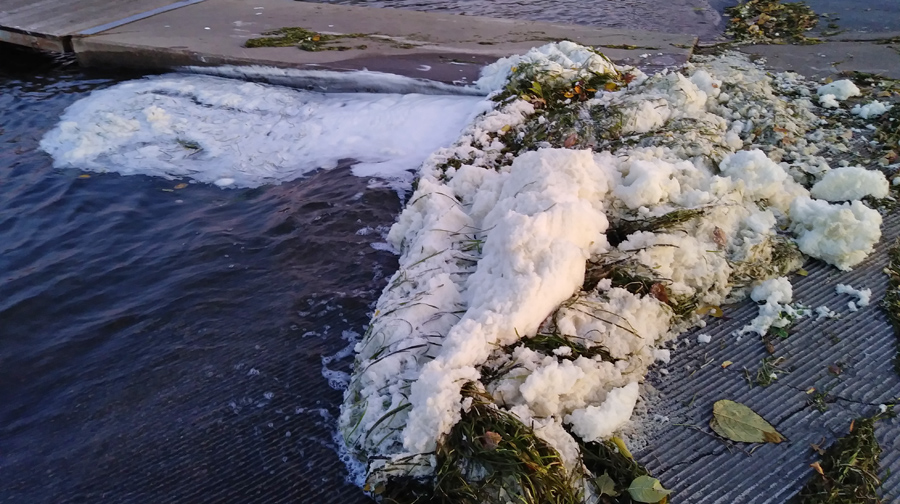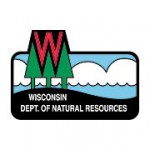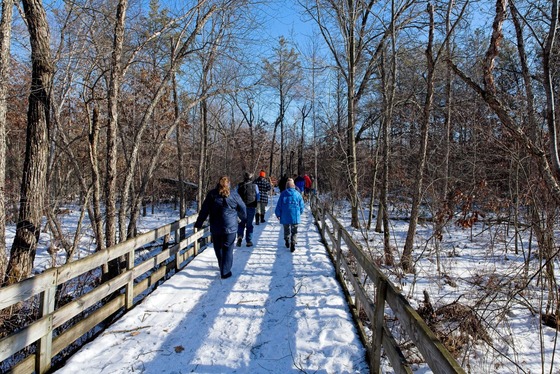DNR Confirms PFAS-Containing Foam Found at the Mouth of Starkweather Creek and Lake Monona

Foam present in Starkweather Creek in October shows elevated levels of PFOS and PFOA. Photo courtesy of the DNR.
MADISON, Wis. – The Department of Natural Resources confirms the presence of PFAS (per- and polyfluoroalkyl substances) foam in Starkweather Creek near Olbrich Boat Launch. The DNR spotted the foam along the creek in late October.
The DNR dispatched contractors to collect and remove the foam and have it analyzed for PFAS. Results showed that elevated levels of PFOS and PFOA were present in the foam (see table below). Results are also available on the DNR’s PFAS webpage.
|
Date Collected |
Location |
Substance Sampled |
Sample Depth |
PFOA (ppt) |
PFOS (ppt) |
|
10/25/2019 |
Olbrich Boat Launch |
Water |
Surface |
9.5 – 10 |
400 |
|
10/25/2019 |
Olbrich Boat Launch |
Foam |
N/A |
460 – 610 |
80,000 – 92,000* |
| *Values are approximations. For additional information, please see the lab report (PDF). PPT is parts per trillion. | |||||
Other PFAS contaminants were also detected in the foam and water samples. Those results can also be found on the PFAS web page.
Given the concentrations of PFAS present in the foam, as well as other contaminants such as bacteria, the DNR and Department of Health Services (DHS) recommend that people avoid making contact with any foam observed on waterways. According to health officials, swallowing foam with PFAS could be a risk to your health, and it’s always best to rinse off after contact with foam. DHS also recommends that people not allow their pets to come into contact with or swallow foam, and that pets also rinse off with fresh water.
Foam observed on state waterways and lakes may or may not contain PFAS. Foam frequently collects on the surface of rivers and lakes due to the buildup of organic compounds from decaying plant or algal material, where wind and wave action pushes them to the shore. It can have bright, white coloring and look like shaving cream, but is lightweight and can blow inland and collect on lake shores and river banks.
PFAS are a group of human-made chemicals used for decades in numerous products, including non-stick cookware, fast food wrappers, stain-resistant sprays and certain types of firefighting foam. These legacy contaminants have made their way into the environment through spills of PFAS-containing materials, discharges of PFAS-containing wastewater to treatment plants and certain types of firefighting foams.
PFAS can persist in the environment and the human body for long periods of time. Recent scientific findings indicate that exposure to certain PFAS may have harmful health effects in people. According to the U.S. Environmental Protection Agency (EPA), exposure to some PFAS substances above certain levels may increase the risk of adverse health effects, such as thyroid disease, low birthweights and cancer.
NOTE: This press release was submitted to Urban Milwaukee and was not written by an Urban Milwaukee writer. While it is believed to be reliable, Urban Milwaukee does not guarantee its accuracy or completeness.
More about the PFAS Problem
- Bipartisan Push to Tell Counties Faster When Water Tests Fail - Henry Redman - Dec 19th, 2025
- MKE County: County Seeks to Sue PFAS Producers, Oil Companies - Graham Kilmer - Dec 10th, 2025
- Wisconsin Reviewing EPA-Approved Pesticides For PFAS - Danielle Kaeding - Dec 9th, 2025
- State Nears Settlement with Johnson Controls/Tyco Over PFAS Spills - Danielle Kaeding - Dec 4th, 2025
- Senate Bill Promotes Soybean-Based Firefighting Foam to Replace PFAS - Danielle Kaeding - Dec 2nd, 2025
- Test Results Show High PFAS Levels in Wisconsin’s Landfill Runoff - Danielle Kaeding - Dec 2nd, 2025
- Wisconsin Communities Get $282 Million for Drinking Water Projects - Danielle Kaeding - Nov 19th, 2025
- Gov. Evers, DNR Announce $282 Million to Improve Drinking Water Quality for Wisconsinites in 74 Municipalities - Gov. Tony Evers - Nov 18th, 2025
- Cleanup of PFAS Could Cost Wisconsin Billions - Danielle Kaeding - Nov 13th, 2025
- Cleanup PFAS Without Penalizing Innocent Landowners - Wisconsin Manufacturers & Commerce - Nov 4th, 2025
Read more about PFAS Problem here
Mentioned in This Press Release
Recent Press Releases by Wisconsin Department of Natural Resources
DNR Confirms CWD in Wild Deer in La Crosse County
Dec 22nd, 2025 by Wisconsin Department of Natural ResourcesBaiting And Feeding Ban Extended























